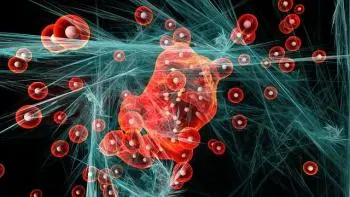
The key difference between an atom and a molecule is that an atom is the fundamental unit of a chemical element, while a molecule is formed by the union of two or more atoms through chemical bonds.
Atoms join to form molecules, and in turn, molecules can join to form more complex structures.
Atom definition
An atom is the basic and smallest unit of a chemical element that maintains its chemical properties.
The atomic structure is composed of a central nucleus that contains positively charged protons and uncharged neutrons, and electrons that orbit the nucleus at different energy levels. Protons have a positive charge, neutrons have no charge, and electrons have a negative charge.
The definition of the structure of atoms has evolved throughout history through atomic models such as the Thomson or Bohr atomic model. However, the current atomic model is the quantum model.
Molecule definition
On the other hand, a molecule is a group of atoms that are linked by chemical bonds. They can be composed of atoms of the same element (as in the case of molecular oxygen, O 2 ) or by atoms of different elements (as in the case of water, H 2 O, which is made up of two hydrogen atoms and one oxygen atom. ).
The chemical bonds that hold atoms together in a molecule can be ionic, covalent, or metallic bonds, depending on how the atoms share, gain, or lose electrons.
Molecules can be composed of the same type of atoms (diatomic molecules such as O 2 or N 2 ) or of different types of atoms (polyatomic molecules such as H 2 O or CO 2 ). The combination of atoms in a molecule determines its properties and chemical behavior.
Examples of Atoms and Molecules
Some additional examples to illustrate the difference are:
-
In the case of molecular oxygen (O 2 ), two oxygen atoms are joined by covalent bonds to form an oxygen molecule.
-
In the case of water (H 2 O), two hydrogen atoms join an oxygen atom through covalent bonds to form a water molecule.
-
In the case of carbon dioxide (CO 2 ), a carbon atom is joined to two oxygen atoms by covalent bonds to form a carbon dioxide molecule.
How are molecules formed?
Molecules are made by joining atoms to form chemical bonds. Through these chemical bonds, two or more atoms come together to share electrons and thus achieve a more stable electronic configuration.
Atoms can be joined by different types of bonds, the most common being covalent bonds and ionic bonds.
Covalent bond
In this type of bond, the atoms share one or more pairs of electrons to complete their outer energy levels. This happens mainly between non-metallic atoms.
Covalent bonds can be single, double, or triple, depending on the number of shared electrons.
Example: In the water molecule (H 2 O), two hydrogen atoms share their electrons with one oxygen atom, forming covalent bonds. Each hydrogen atom shares a pair of electrons with the oxygen atom.
Ionic bond
In this type of bond, atoms transfer electrons to form electrically charged ions. This occurs when one atom donates electrons and becomes a positively charged ion (cation), while another atom accepts electrons and becomes a negatively charged ion (anion).
Oppositely charged ions attract and bond to form an ionic bond.
Example: In the sodium chloride (NaCl) molecule, the sodium atom donates an electron to the chlorine atom. As a result, the sodium atom becomes a Na+ cation and the chlorine atom becomes a Cl- anion. Na+ and Cl- ions are electrostatically attracted to each other and form the sodium chloride molecule.